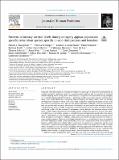Files in this item
Patterns of urinary cortisol levels during ontogeny appear population specific rather than species specific in wild chimpanzees and bonobos
Item metadata
| dc.contributor.author | Tkaczynski, Patrick J. | |
| dc.contributor.author | Behringer, Verena | |
| dc.contributor.author | Ackermann, Corinne Y. | |
| dc.contributor.author | Fedurek, Pawel | |
| dc.contributor.author | Fruth, Barbara | |
| dc.contributor.author | Girard-Buttoz, Cédric | |
| dc.contributor.author | Hobaiter, Catherine | |
| dc.contributor.author | Lee, Sean M. | |
| dc.contributor.author | Löhrich, Therese | |
| dc.contributor.author | Preis, Anna | |
| dc.contributor.author | Samuni, Liran | |
| dc.contributor.author | Zommers, Zinta | |
| dc.contributor.author | Zuberbühler, Klaus | |
| dc.contributor.author | Deschner, Tobias | |
| dc.contributor.author | Wittig, Roman M. | |
| dc.contributor.author | Hohmann, Gottfried | |
| dc.contributor.author | Crockford, Catherine | |
| dc.date.accessioned | 2020-09-07T09:30:02Z | |
| dc.date.available | 2020-09-07T09:30:02Z | |
| dc.date.issued | 2020-10 | |
| dc.identifier | 270006056 | |
| dc.identifier | f4c35cbe-49d0-4d00-8a44-4886bcead618 | |
| dc.identifier | 85089892648 | |
| dc.identifier | 000579075400006 | |
| dc.identifier.citation | Tkaczynski , P J , Behringer , V , Ackermann , C Y , Fedurek , P , Fruth , B , Girard-Buttoz , C , Hobaiter , C , Lee , S M , Löhrich , T , Preis , A , Samuni , L , Zommers , Z , Zuberbühler , K , Deschner , T , Wittig , R M , Hohmann , G & Crockford , C 2020 , ' Patterns of urinary cortisol levels during ontogeny appear population specific rather than species specific in wild chimpanzees and bonobos ' , Journal of Human Evolution , vol. 147 , 102869 . https://doi.org/10.1016/j.jhevol.2020.102869 | en |
| dc.identifier.issn | 0047-2484 | |
| dc.identifier.other | RIS: urn:4BBF8DCE2A25EB3426128956FDD7C043 | |
| dc.identifier.other | ORCID: /0000-0001-8378-088X/work/80257437 | |
| dc.identifier.other | ORCID: /0000-0002-3893-0524/work/80257788 | |
| dc.identifier.uri | https://hdl.handle.net/10023/20573 | |
| dc.description.abstract | Compared with most mammals, postnatal development in great apes is protracted, presenting both an extended period of phenotypic plasticity to environmental conditions and the potential for sustained mother-offspring and/or sibling conflict over resources. Comparisons of cortisol levels during ontogeny can reveal physiological plasticity to species or population specific socioecological factors and in turn how these factors might ameliorate or exaggerate mother-offspring and sibling conflict. Here, we examine developmental patterns of cortisol levels in two wild chimpanzee populations (Budongo and Taï), with two and three communities each, and one wild bonobo population (LuiKotale), with two communities. Both species have similar juvenile life histories. Nonetheless, we predicted that key differences in socioecological factors, such as feeding competition, would lead to interspecific variation in mother-offspring and sibling conflict and thus variation in ontogenetic cortisol patterns. We measured urinary cortisol levels in 1394 samples collected from 37 bonobos and 100 chimpanzees aged up to 12 years. The significant differences in age-related variation in cortisol levels appeared population specific rather than species specific. Both bonobos and Taï chimpanzees had comparatively stable and gradually increasing cortisol levels throughout development; Budongo chimpanzees experienced declining cortisol levels before increases in later ontogeny. These age-related population differences in cortisol patterns were not explained by mother-offspring or sibling conflict specifically; instead, the comparatively stable cortisol patterns of bonobos and Taï chimpanzees likely reflect a consistency in experience of competition and the social environment compared with Budongo chimpanzees, where mothers may adopt more variable strategies related to infanticide risk and resource availability. The clear population-level differences within chimpanzees highlight potential intraspecific flexibility in developmental processes in apes, suggesting the flexibility and diversity in rearing strategies seen in humans may have a deep evolutionary history. | |
| dc.format.extent | 12 | |
| dc.format.extent | 784057 | |
| dc.language.iso | eng | |
| dc.relation.ispartof | Journal of Human Evolution | en |
| dc.subject | Life history | en |
| dc.subject | Childhood | en |
| dc.subject | Development | en |
| dc.subject | Glucocorticoids | en |
| dc.subject | Hominin evolution | en |
| dc.subject | BF Psychology | en |
| dc.subject | NDAS | en |
| dc.subject.lcc | BF | en |
| dc.title | Patterns of urinary cortisol levels during ontogeny appear population specific rather than species specific in wild chimpanzees and bonobos | en |
| dc.type | Journal article | en |
| dc.contributor.institution | University of St Andrews. School of Psychology and Neuroscience | en |
| dc.contributor.institution | University of St Andrews. Centre for Social Learning & Cognitive Evolution | en |
| dc.contributor.institution | University of St Andrews. Institute of Behavioural and Neural Sciences | en |
| dc.identifier.doi | https://doi.org/10.1016/j.jhevol.2020.102869 | |
| dc.description.status | Peer reviewed | en |
This item appears in the following Collection(s)
Items in the St Andrews Research Repository are protected by copyright, with all rights reserved, unless otherwise indicated.

